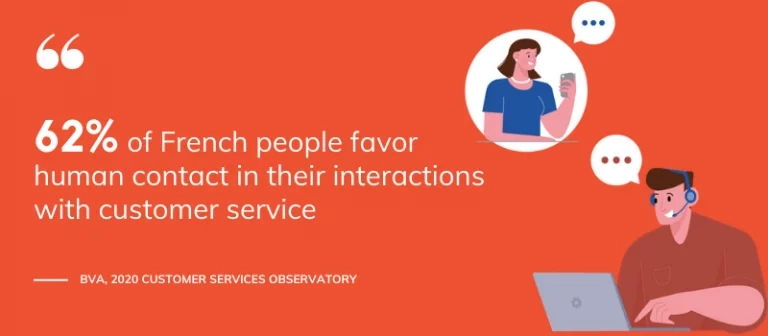What are the benefits of visual assistance
for customer relations?



In a world where digital is becoming more and more important, interactions between a company and its customers are often impersonal. Brands, like their consumers, would like to establish real human relationships. Visual assistance integrated into customer service improves the service provided and the customer relationship while guaranteeing remote human contact. Providing a visual communication channel offers several advantages to both the company and its customers. By ensuring better mutual understanding, remote assistance positively influences customer satisfaction, after-sales service management and branding.
Customer satisfaction is one of the first challenges for companies. Indeed, a satisfied customer remains mostly more loyal to a brand and is more inclined to spend and try new products. This is especially important when you know that attracting a new customer costs five times more than keeping an existing one. Thus, loyalty would increase a company’s sales at a lower cost than acquiring new customers. Here’s how visual assistance can help you improve customer satisfaction:

Time is an important unit of measure in evaluating the efficiency of a service. On a traditional after-sales service model, the customer calls customer service and spends some time describing his problem. With visual assistance, it is no longer necessary to describe in words or to search for precise technical terms, it is only necessary to show the technician the defective device for a faster diagnosis. Incidents are thus handled on average twice as fast as on the phone.
In 40% of cases, the breakdowns are not really breakdowns, and maintenance advice is enough to solve problems. In these situations, problems can be fixed on the first call, remotely, with the advice of technicians who guide customers to diagnose and solve problems.
Generally, it can take several days between the moment the customer calls customer service and the moment a technician comes to carry out a repair, while on a proven breakdown, visual assistance makes it possible to carry out a troubleshooting remotely thanks to the collaboration of the technician and the customer.
For large equipment, a first visit is often necessary to make a diagnosis and order the parts necessary for repair. During this time, customers can no longer use their equipment. With visual assistance, this first visit can be avoided since the remote diagnosis makes it possible to quickly understand the breakdown and to know which parts to order to optimize the intervention on the customer’s premises.
After-sales service is a key service in customer support. To improve the customer experience, optimizing after-sales service management is essential to simplify the work of advisers while providing the necessary satisfaction to customers. While the after-sales service is often perceived as a cost center in companies, a better organization of the service would allow it to be perceived as a profit center. Visual assistance optimizes after-sales service operations and therefore reduces costs.
An economic and non-negligible advantage of visual assistance is the reduction in travel by technicians. While remote assistance improves processing times and increases resolution on the 1st call, it proportionally avoids unnecessary travels and reduces the costs associated with these trips. According to Praxedo, a technician’s travel time is between one-third and half of his workday. Visual assistance thus optimizes interventions and contributes to better productivity.
Remote support helps solve customer problems faster with real-time video. As a result, customer service can handle more requests and satisfy more customers. In addition, visual assistance allows technicians to intervene only when necessary. Therefore, the waiting time for imperative interventions is greatly reduced.
In addition to saving time for after-sales service and customers, visual assistance significantly reduces product returns. Indeed, in a traditional after-sales service, it often happens that the advisor asks the customer to return the product that is causing the problem so that the internal teams can analyze it. In the USA, each year, the product returns represent the equivalent of 260 billion dollars (NY Post). Visual assistance can be used to resolve the incident instantly and thus save money on the processing of product returns.

Brands are finding it increasingly difficult to retain their customers and rely on hyperpersonalization and customer experience to address this issue. In addition, consumers’ expectations are changing and refocusing on the essentials. They are looking for companies that are able to listen to them and understand their needs and expect more proximity, simplicity and meaning. Companies have to adapt and rethink their organization in order to remain interesting and relevant for consumers. Visual assistance integrated to customer service allows companies to reinforce their brand image.
According to the 2020 Customer Services Observatory, 62% of French people prefer human contact in their interactions with customer service. Consumers therefore attach particular importance to the quality of human relations. The use of visual assistance creates a strong link and helps to humanize the customer relationship. The proximity conferred by the video allows a company to combine human and remote relationships. Moreover, a company that offers visual assistance benefits from an innovative and professional image with its consumers, thus helping to create a significant customer experience.

Competition is increasing in many sectors which increases consumer demand. According to an Accenture study, customer expectations “are influenced by the most relevant and dynamic real-time experiences available in other industries.” The use of visual assistance for customer service proves to be a differentiating factor in a competitive environment. Indeed, its many advantages such as time savings, better understanding of needs or even personalization allow companies to increase customer satisfaction and therefore, correlatively, strengthen their brand image.
Today, many companies want to reduce their environmental impact and implement a CSR approach. Corporate social responsibility consists of companies taking into account the challenges of sustainable development (economic, social and ecological) in their activities and interactions. From this perspective, the use of visual assistance is a good solution to limit carbon emissions. In fact, opting for real-time video instead of travel helps to reduce the carbon footprint in the long term. A study by Greenspector has shown that the use of video can reduce the impact of physical travel.

By integrating a visual assistance solution, a company’s customer service will benefit from its many advantages. Simplicity, speed, cost reduction, remote assistance is a major asset for brands looking for improvement. At Apizee, we support players such as FNAC-Darty, Groupe Atlantic and Auchan Services in the implementation and use of visual assistance for after-sales service. Do not hesitate to contact us to find out more about our solutions and our tailor-made support.

Explore key findings from the Genesys State of Customer Experience report. Learn how AI, omnichannel strategies, and video chat are transforming CX and enhancing customer satisf...
The State of Customer Experience report by Genesys : Key Insights and Trends
27 Mar 2025
Despite AI and automation, customers still prefer to speak to a human for support. Discover why human interaction remains essential for great customer service.
Why Customers Still Want to Speak to a Human in Customer Service
17 Mar 2025
Discover the top customer experience influencers in Europe, shaping the future of CX and customer service.
Top 100 Customer Experience Influencers to follow
10 Mar 2025
Interested in our solutions?